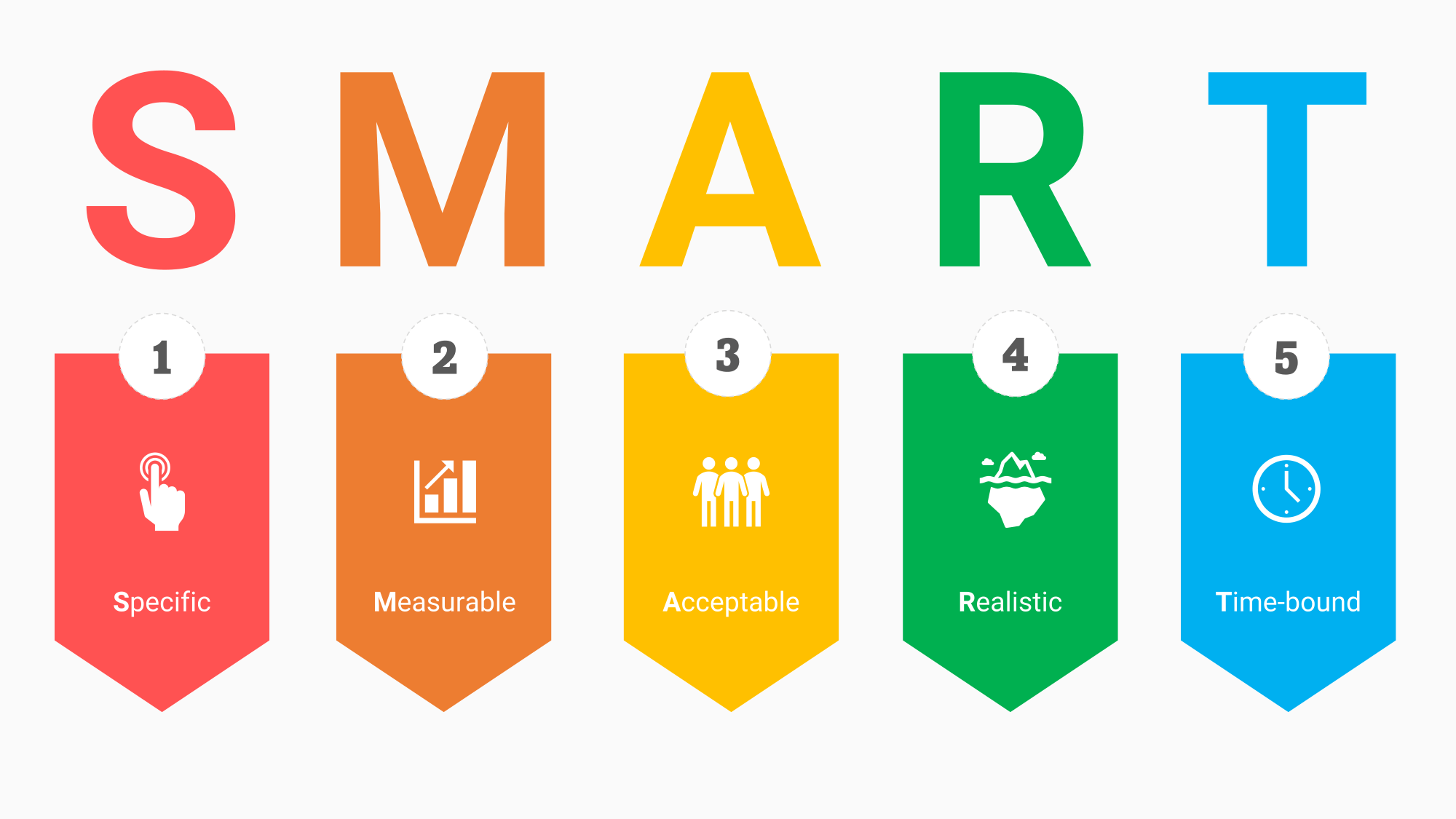Define SMART in your organization
SMART stands for Specific, Measurable, Acceptable, Realistic, and Time-bound – an acronym designed to help you formulate (learning) goals in a structured way. Essentially, it means describing your goals thoughtfully and within a clear framework. In theory, this method significantly increases your chances of achieving your goals sooner because it requires you to define them more precisely. This makes your goals concrete and measurable. After all, you want to be able to track and monitor the progress of your SMART objectives to make necessary adjustments. They should also be acceptable and realistic. Incidentally, the “A” can also stand for Ambitious or Achievable. Setting the bar high often leads to better performance. However, some fear SMART goals. This article explores the definition of SMART and explains the 5 key concepts of SMART goal setting, especially within an organizational context. We’ll share 25 concrete examples, add a “C” to SMART, and conclude with 7 practical tips.
What does SMART stand for? What is SMART?
SMART stands for Specific, Measurable, Acceptable, Realistic, and Time-bound. The SMART method ensures that your goals are clearly defined and actionable, avoiding vague or unattainable objectives or overly abstract language that no one can work with. The acronym first appeared in management literature in 1981 in a seminal article by management expert George T. Doran. But first, let’s clarify the method:
SMART is a framework with five key principles that requires you to formulate your goals specifically, measurably, acceptably, realistically, and within a defined timeframe.
This method helps you turn aspirations into actionable goals. If a goal is completely unrealistic, the SMART approach helps ground it in reality. In this sense, SMART is not just a method but also a mindset or habit that encourages clarity and practicality. However, the rigid nature of SMART can sometimes lead to anxiety and stress – more on that later.
Each principle requires a thorough explanation. For instance, how do you make your goals specific and measurable? And how do you ensure they are realistic or acceptable to the individuals tasked with achieving them? We’ll cover these questions in the SMART explanation section, and you can also check out the SMART example for more insight.
SMART explanation: the 5 principles
The SMART framework is built around five core principles that should always be applied consistently:
 Figure 1: The meaning of SMART and its abbreviation: Specific, Measurable, Acceptable, Realistic, and Time-bound.
Figure 1: The meaning of SMART and its abbreviation: Specific, Measurable, Acceptable, Realistic, and Time-bound.
- Specific: define the goal as clearly and specifically as possible.
- Measurable: ensure the goal can be tracked and measured using KPIs.
- Acceptable: make the goal acceptable to everyone involved.
- Realistic: set a goal that is achievable and realistic.
- Time-bound: establish a deadline for when the goal should be completed.
It’s important to distinguish between personal goals and organizational goals. For personal goals, formulating them using the SMART method is relatively straightforward. Whether the goal is acceptable is primarily up to the individual. However, for organizational goals, it’s essential to ensure that colleagues have input, and that the SMART goals are aligned with shared objectives.
1. Specific
 Make the objective as specific as possible. For example, instead of saying, “I want to graduate from a cool company,” you could say, “I want to graduate from a company in the space industry,” or even more specifically, “SpaceX.” Similarly, if your goal is to create a safer workplace for employees, you can make it more specific by stating, “Reduce the number of factory accidents to zero.” The motto here is: the more specific, the better. In some cases, this means breaking down a general goal into smaller, concrete sub-goals.
Make the objective as specific as possible. For example, instead of saying, “I want to graduate from a cool company,” you could say, “I want to graduate from a company in the space industry,” or even more specifically, “SpaceX.” Similarly, if your goal is to create a safer workplace for employees, you can make it more specific by stating, “Reduce the number of factory accidents to zero.” The motto here is: the more specific, the better. In some cases, this means breaking down a general goal into smaller, concrete sub-goals.
2. Measurable
 Measurable means you can track your progress and know when you’ve achieved your goal. A SMART goal should be formulated so that its progress can be quantified. You make a goal measurable by identifying a KPI (Key Performance Indicator) and collecting data to monitor it.
Measurable means you can track your progress and know when you’ve achieved your goal. A SMART goal should be formulated so that its progress can be quantified. You make a goal measurable by identifying a KPI (Key Performance Indicator) and collecting data to monitor it.
For instance, a car factory aiming to speed up production might set a KPI such as the number of minutes a car spends in the 15-step production process. At the final step, the car is completed. The factory measures every car’s progress through the process, step by step, to calculate the total production time. This also helps identify bottlenecks, making it easier to work toward the SMART goal.
The SMART KPI Guide 2025 Having SMART goals is step one, but how do you determine if you're making progress towards achieving those goals? You need SMART KPIs. Passionned Group's SMART KPI Guide will help you define the essential KPIs for your organization. This essential handbook contains many KPI examples from a myriad of industries, as well as in-depth explanations and exercises.
Having SMART goals is step one, but how do you determine if you're making progress towards achieving those goals? You need SMART KPIs. Passionned Group's SMART KPI Guide will help you define the essential KPIs for your organization. This essential handbook contains many KPI examples from a myriad of industries, as well as in-depth explanations and exercises.
3. Acceptable
 For a goal to be effective, it must be acceptable to all stakeholders. For example, if management sets a goal of producing each car within two days, the factory management might find this unacceptable. Luxury cars with more complex features naturally require more time. After analyzing the data and negotiating, the teams agree on a more realistic goal of three days for luxury cars. This compromise ensures the goal is accepted by both management and workers, fostering a sense of ownership and dedication to achieving it.
For a goal to be effective, it must be acceptable to all stakeholders. For example, if management sets a goal of producing each car within two days, the factory management might find this unacceptable. Luxury cars with more complex features naturally require more time. After analyzing the data and negotiating, the teams agree on a more realistic goal of three days for luxury cars. This compromise ensures the goal is accepted by both management and workers, fostering a sense of ownership and dedication to achieving it.
4. Realistic
 A goal must be realistic to be achievable. For every goal, you should assess its feasibility. For example, given the current state of space technology, it’s unrealistic to expect a manned mission to Mars within two years. Similarly, setting a goal to lose 20 kilograms in five days is improbable and unhealthy. Unrealistic goals often lead to failure and loss of motivation. While it’s important to aim high, avoid setting goals that are overly ambitious or unattainable. Check out the 5 keys to successful SMART goals for more insight.
A goal must be realistic to be achievable. For every goal, you should assess its feasibility. For example, given the current state of space technology, it’s unrealistic to expect a manned mission to Mars within two years. Similarly, setting a goal to lose 20 kilograms in five days is improbable and unhealthy. Unrealistic goals often lead to failure and loss of motivation. While it’s important to aim high, avoid setting goals that are overly ambitious or unattainable. Check out the 5 keys to successful SMART goals for more insight.
5. Time-bound
 The “T” in SMART stands for time-bound, meaning every goal should have a deadline. For example, a hospital’s medical board might set a time-bound goal to reduce the percentage of post-treatment complications. If the current rate fluctuates between 20% and 40%, they might set a goal to lower it to no more than 15% by December 31 of the following year. Adding a specific deadline keeps everyone focused on achieving the goal within a defined timeframe.
The “T” in SMART stands for time-bound, meaning every goal should have a deadline. For example, a hospital’s medical board might set a time-bound goal to reduce the percentage of post-treatment complications. If the current rate fluctuates between 20% and 40%, they might set a goal to lower it to no more than 15% by December 31 of the following year. Adding a specific deadline keeps everyone focused on achieving the goal within a defined timeframe.
The fear of SMART goals
 It’s important not to overlook the human side of goal setting. For many, setting goals can be a daunting task that feels time-consuming and stressful. This discomfort is one reason why the majority of organizations fail to implement SMART goals effectively.
It’s important not to overlook the human side of goal setting. For many, setting goals can be a daunting task that feels time-consuming and stressful. This discomfort is one reason why the majority of organizations fail to implement SMART goals effectively.
Many executives focus on immediate, day-to-day concerns, particularly when their performance is judged over the short term.
The process of formulating SMART goals often leads to anxiety and a sense of unease. People tend to prefer avoiding written goals because once goals are clearly articulated, there’s a sense of accountability that can be emotionally challenging. However, this accountability is essential. Without SMART goals, management lacks direction, and performance management struggles to take shape.
The SMART method is all about knowledge
At its core, the SMART method is all about knowledge. To make a goal specific, you need expertise in the relevant domain, industry, or discipline. To make it measurable, you must understand the process, available capabilities, and data. To ensure it’s acceptable, you need insight into the people, tools, and skills involved. In other words, formulating SMART goals requires a deep dive into the details. The success of this method depends on building strong, comprehensive knowledge.
The quickest way to gain insight into the progress of your SMART goals is through KPIs, data analysis, and making dashboards. These tools transform SMART goals into a dynamic, actionable system and prevent them from fading into obscurity. For more insights, check out our 7 tips and the SMART KPI Guide 2025.
A SMART example
When formulating SMART goals, it’s important to focus on what truly matters – something you genuinely want to achieve and excel at. The following example demonstrates how the Fire Department translated its mission into concrete goals using the SMART method.
 Figure 2: SMART goals example at the Fire Department – translating the mission into SMART goals.
Figure 2: SMART goals example at the Fire Department – translating the mission into SMART goals.
- Excel: A modern manager boldly identifies what the organization wants or needs to excel at. Goals become meaningful and give employees a sense of purpose and passion. They understand not only the SMART framework but also the deeper significance of the goals.
- Move: Determine what steps you can take together toward the ultimate goal. Outline intermediate steps and sub-goals along the way, while clarifying your personal ambitions and those of the organization.
- Measure: Make progress toward the goal measurable by defining KPIs. Continuously monitor progress together, following Dr. Deming’s improvement cycle: Plan-Do-Check-Act.
- Standardize: Establish specific target values (norms) for the KPIs. Adjust these norms regularly as needed. For example, absenteeism might be capped at no more than 4%.
- Achieve: Identify the actions you will take together to achieve the SMART goal.
The key to effective SMART goal setting is always tying goals to the higher purpose of the project or organization – like the Fire Department’s mission. When you align goals with that purpose, you can’t go wrong.
Higher and lower SMART goals
 Now we arrive at a critical aspect of the SMART framework. The goals you set must align with the organization’s overarching goals, especially its mission. Higher-level goals should translate into more specific, lower-level goals. Conversely, lower-level goals should reinforce and contribute to higher-level objectives. For example, marketing goals should align with sales goals, while production goals should complement HR objectives.
Now we arrive at a critical aspect of the SMART framework. The goals you set must align with the organization’s overarching goals, especially its mission. Higher-level goals should translate into more specific, lower-level goals. Conversely, lower-level goals should reinforce and contribute to higher-level objectives. For example, marketing goals should align with sales goals, while production goals should complement HR objectives.
The more consistently you apply this principle, the more cohesive and impactful your SMART goals will be. For personal goals, this alignment is less complex – you don’t need to account for as many factors. However, you may still want to ensure your goals align with the life you share with a partner, children, or friends.
Make your SMART goals compatible
Organizations often formulate numerous strategic, tactical, and operational goals – many of which are vague, excessive, or poorly defined. To ensure success, it’s essential to streamline and unify these goals. This means not only making them SMART but also aligning them with one another. Achieving this requires effort, as it involves engaging in discussions and collaboration.
These conversations are crucial because dialogue leads to clearer, more specific goals and shared understanding. This is why we can add a “C” to SMART, making it SMART-C – where the “C” stands for Compatible. One of the most effective tools for ensuring compatibility between goals is the Balanced Scorecard framework.
Explore the Balanced Scorecard
Replace SMART goals with KPIs
 What’s the difference between key performance indicators (KPIs) and SMART goals? The acronym SMART is often misused, with people mistakenly saying that KPIs need to be made SMART. However, KPIs themselves cannot be made SMART – this applies only to goals. So, what sets them apart?
What’s the difference between key performance indicators (KPIs) and SMART goals? The acronym SMART is often misused, with people mistakenly saying that KPIs need to be made SMART. However, KPIs themselves cannot be made SMART – this applies only to goals. So, what sets them apart?
A goal is something you aim to achieve in the future, initially expressed as a general statement, such as: “We strive for a safe workplace.” KPIs, on the other hand, are the tools you use to measure whether and how you are achieving that goal. For example, you could track the “number of accidents” as a KPI.
Next, you define a target or benchmark for the KPI, such as a maximum of two accidents per year. This process quantifies the goal and gives it a measurable framework. Rather than focusing solely on SMART goals, it might be more effective to develop concrete KPIs, along with clear norms, targets, and a KPI tree. This approach allows you to achieve clarity and alignment simultaneously.
Formulating SMART goals without a solid understanding of KPIs is like trying to use a weapon without ammunition.
25 examples of SMART goals
Below are examples of (partially) SMART-formulated goals across various sectors:
- Hotels: Achieve 80% occupancy for regular hotel rooms by the end of the year.
- Call centers: Reduce the average waiting time to no more than 30 seconds.
- Production: Decrease process waste to no more than 1% of materials.
- Smartphone manufacturers: Expand direct-to-consumer sales channels to 50 countries by 2035.
- Supermarkets: Open 18 additional stores in the northern region next year.
- Personal: Lose six pounds within two weeks.
- Government: Increase the employment rate in our municipality to at least 75% by year-end.
- Healthcare: Keep the complication rate for simple surgeries below 15% in our hospital.
- Housing: Reduce household energy consumption by 25% through efficiency programs and incentives.
- Webshops: Lower the percentage of returned clothing purchases to a maximum of 20% by the end of 2025.
- City of Austin: Develop 100,000 new affordable housing units by 2030.
- Transportation: Ensure ride punctuality is at least 97% this year.
- City: Ensure noise levels in residential zones do not exceed 55 dB at night.
- Banking: Reduce mortgage payment arrears to a maximum of five days.
- Police: Decrease violent crime by 10% by the end of 2025.
- Marketing: Ensure at least 25% of emails from a campaign are opened.
- Telecom: Maintain 99% network availability nationwide, regardless of location.
- Waste recycling: Recycle at least 50% of collected waste into reusable materials by the end of next year.
- Energy: Ensure new commercial buildings receive electricity service within six months by 2030.
- Sports: Run at least 20 minutes daily starting next week, regardless of weather conditions.
- Media: Increase viewership by 1% monthly until reaching 30% market share during evening broadcasts.
- Personnel: Limit long-term sick leave to no more than 3.5%.
- Recruitment: Achieve a candidate placement rate of 60% by the end of next year.
- Property management company: Ensure rental units remain vacant for no more than 23 days on average before new tenants move in.
- Mental health care: Ensure at least 65% of clients are symptom-free after treatment.
Important note: Not all of the above goals are fully SMART. Some lack specific deadlines (which can be easily addressed), while others may not be acceptable or realistic in their context. For example, a measure like ‘reducing screen time to just 30 minutes a day’ might face resistance from family members, making the goal unacceptable and therefore not SMART.
The 5 keys to successful SMART goal setting
 In 2002, two renowned American scientists, Edwin A. Locke and Gary P. Latham, published a widely acclaimed article on goal setting in American Psychologist. Drawing on 35 years of scientific research, they identified five keys to achieving SMART goal success. These principles may seem straightforward, but they remain just as relevant today:
In 2002, two renowned American scientists, Edwin A. Locke and Gary P. Latham, published a widely acclaimed article on goal setting in American Psychologist. Drawing on 35 years of scientific research, they identified five keys to achieving SMART goal success. These principles may seem straightforward, but they remain just as relevant today:
- Setting specific, challenging goals leads to consistently higher performance compared to simply asking employees to “do their best.”
- High, ambitious goals encourage greater effort from employees than easier or low-level goals. In fact, the hardest-to-achieve goals inspire maximum effort and often lead to top performance.
- Tight deadlines drive higher productivity compared to flexible or open-ended timelines.
- Publicly committing to certain goals increases personal accountability and effort toward achieving them.
- Whether goals are created collaboratively between an employee and their supervisor or imposed by management, it has little impact on overall goal achievement.
While these principles are compelling, it’s equally important to evaluate goals effectively. The key question is: How, and how often, will you assess whether goals have been met and evaluate employee performance?
Research by Kilian Wawoe, a Human Resources Management lecturer at VU University Amsterdam, shows that the traditional annual performance review is not only ineffective but also demotivating. After seven years of study, Wawoe concluded that this annual ritual often leaves both managers and employees frustrated and has no positive impact on performance.
Replace annual reviews with ongoing coaching
Wawoe recommends eliminating traditional performance reviews and replacing them with continuous coaching and feedback. This approach shifts the focus from past performance to how employees can contribute more effectively to achieving the team’s and organization’s SMART objectives.
This shift is critical because, according to research, more than 75% of employees in most organizations have no clear understanding of how their daily tasks contribute to the organization’s higher goals. Continuous coaching and dialogue help bridge this gap, ensuring that employees stay aligned and motivated to achieve their goals.
Practicing with the SMART goals form
To evaluate a goal using the SMART framework, you can use the form provided below. Simply fill out the SMART goals form to verify that you’ve applied the method correctly.
 Figure 3: Start creating SMART goals with our convenient form. Click on the image to download it. You can also save it by right-clicking and selecting “Save Image As…”
Figure 3: Start creating SMART goals with our convenient form. Click on the image to download it. You can also save it by right-clicking and selecting “Save Image As…”
Keep in mind that the SMART method doesn’t guarantee that pursuing a specific goal is the right decision. It’s more like a spell checker – helping you ensure your goal is well-structured but not necessarily the best choice.
The SMART principle is like a spell checker
 The SMART method is best viewed as a kind of spell checker – it can identify structure and style errors in a goal but doesn’t evaluate the content or whether the goal itself is a good idea. To extend this analogy:
The SMART method is best viewed as a kind of spell checker – it can identify structure and style errors in a goal but doesn’t evaluate the content or whether the goal itself is a good idea. To extend this analogy:
A goal can meet all SMART criteria and still be an unhelpful idea.
Another crucial point to consider: the SMART method may unintentionally encourage the creation of easy-to-achieve goals. People tend to avoid setting goals that seem unrealistic or unattainable. Those who are less confident may focus excessively on the “A” (Acceptable) and “R” (Realistic) in the acronym to justify setting low-bar goals that require minimal effort.
However, research shows that ambitious, challenging, and demanding goals ultimately inspire the highest levels of commitment and performance. For more on this, refer to the previously mentioned 5 keys to SMART success.
Seven practical tips
 Based on research and years of experience with the SMART method, here are seven practical tips to help you make the most of it:
Based on research and years of experience with the SMART method, here are seven practical tips to help you make the most of it:
- The letter “A” in SMART is crucial. Goals should be both acceptable and ambitious. It’s a balancing act – start with goals that feel achievable to build momentum, but gradually raise the bar to keep challenging yourself and your team.
- For ambitious end goals, break them down into smaller milestones with their own SMART objectives. Visualizing these milestones makes the process more practical and significantly increases the likelihood of success.
- The letter “M” (Measurable) is central to the SMART method. Once your goal is specific enough, create KPIs to measure progress. Define a target or benchmark for each KPI and set a deadline for achieving it. Transition from the SMART framework to KPI tracking at the right time.
- If all goals in your organization or department are SMART, ensure they are compatible and aligned. Tools like the Balanced Scorecard can help integrate goals so they don’t conflict but instead reinforce one another.
- SMART goals should drive continuous improvement and process optimization. Check whether your organization’s culture supports this mindset. Ensure the goals are actionable and aligned with a drive for consistent progress.
- Even if you have carefully formulated your goals using the SMART method, always make sure the goal itself is truly meaningful.
- Does the end always justify the means? When you become too focused on competition and achieving goals at all costs, you risk creating problems for other departments, organizations, or even society. A goal may seem acceptable – or even essential – to you, but that doesn’t mean it aligns with the values or priorities of others. Be mindful of the ethical implications of SMART goals, as ignoring them could damage relationships and lead to unintended consequences.
Now you may be wondering, What do I actually gain from all these SMART goals? Why invest so much effort in what could feel like a bureaucratic exercise? It’s a fair question. SMART goals only have real value if they are actively managed using KPIs and dashboards. But even those tools are only effective if employees are genuinely engaged with the organization and its mission.
In short, for SMART goals to work, you need a culture that prioritizes continuous improvement, where the human element remains at the core of the approach.
Delve further into SMART goals & KPIs here
 Explore this fascinating topic in more depth. Click on any of the following links to learn more about closely related subjects:
Explore this fascinating topic in more depth. Click on any of the following links to learn more about closely related subjects:
Give SMART meaning with passion
The specialists at Passionned Group are here to help you take the next step in implementing SMART goals and KPIs, guiding you toward becoming an intelligent, data-driven organization. Thinking about implementing SMART? Contact us today to schedule an introductory meeting.
About Passionned Group
 Passionned Group is a leading expert in SMART goals, continuous improvement, and building smart organizations. Our experienced consultants support businesses and governments in their transition to becoming SMART organizations. Every two years, we proudly host the election for the Smartest Organization in the Netherlands.
Passionned Group is a leading expert in SMART goals, continuous improvement, and building smart organizations. Our experienced consultants support businesses and governments in their transition to becoming SMART organizations. Every two years, we proudly host the election for the Smartest Organization in the Netherlands.
Frequently Asked Questions
What does SMART goals stand for?
SMART stands for Specific, Measurable, Acceptable, Realistic, and Time-bound. Read the full explanation here.
Are there SMART KPIs?
No, KPIs themselves cannot be made SMART. Instead, you use KPIs to make a goal SMART.
How can SMART goals help you to be successful?
It provides clarity for everyone about the goals being pursued and increases knowledge about your business model, processes, and organization.
What is the biggest pitfall?
Failing to transition from a “paper tiger” to a dynamic system with KPIs and dashboards.
What does SMART require from management?
It requires courage and determination to set ambitious SMART goals and manage accordingly. This demands a performance-oriented culture where continuous improvement and constructive feedback are ingrained habits.
Is a SMART organization a solution for everything?
No, but it offers a framework for all activities within the organization. SMART serves as the foundation for building an intelligent, data-driven organization.


